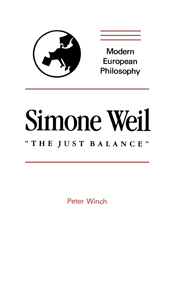Book contents
- Frontmatter
- Contents
- Acknowledgements
- 1 Introduction
- 2 The Cartesian background
- 3 The sensations of the present moment
- 4 “La simple perception de la nature est une sorte de danse”
- 5 Language
- 6 Necessity
- 7 Equilibrium
- 8 “Completely free action”
- 9 The power to refuse
- 10 “The void”
- 11 Geometry
- 12 Incommensurability
- 13 Beauty
- 14 Justice
- 15 “A supernatural virtue”?
- Notes
- Bibliography
- Index
- Frontmatter
- Contents
- Acknowledgements
- 1 Introduction
- 2 The Cartesian background
- 3 The sensations of the present moment
- 4 “La simple perception de la nature est une sorte de danse”
- 5 Language
- 6 Necessity
- 7 Equilibrium
- 8 “Completely free action”
- 9 The power to refuse
- 10 “The void”
- 11 Geometry
- 12 Incommensurability
- 13 Beauty
- 14 Justice
- 15 “A supernatural virtue”?
- Notes
- Bibliography
- Index
Summary
I want to break off my consideration of justice at this point and reflect first on the role played by beauty in Simone Weil's thinking. As the following passage shows, she sees a very close connection between them.
The love of the order and beauty of the world is thus the complement of the love of our neighbour.
It proceeds from the same renunciation, the renunciation which is an image of the creative renunciation of God. God causes the universe to exist, but he consents not to command it, although he has the power to do so. Instead he leaves two other forces to rule in his place. On the one hand there is the blind necessity attaching to matter, including the psychic matter of the soul, and on the other hand the autonomy essential to thinking persons.
By loving our neighbour we imitate the divine love which created us and all our fellows. By loving the order of the world we imitate the divine love which created this universe of which we are a part.
I recognize the apparent absurdity of trying to reflect on these striking ideas in abstraction from their religious dimension, but this is what, for the present, I want to do. I shall try to say something in my concluding chapter about the relation between these reflections and that religious dimension.
- Type
- Chapter
- Information
- Simone Weil: "The Just Balance" , pp. 164 - 178Publisher: Cambridge University PressPrint publication year: 1989

